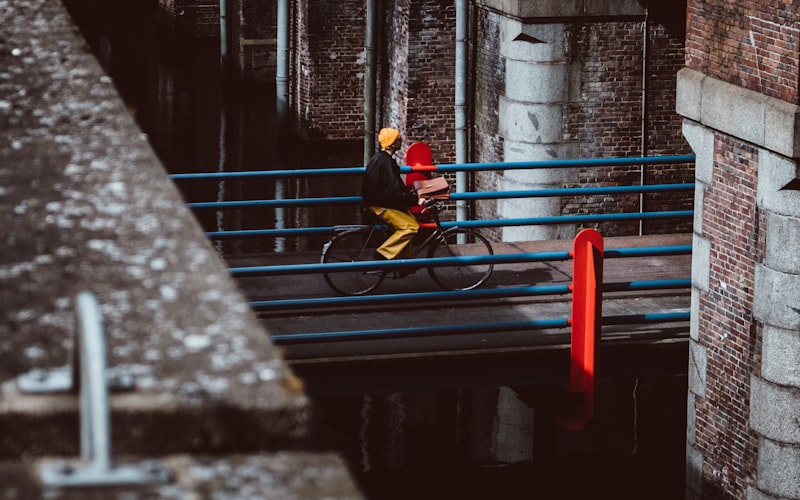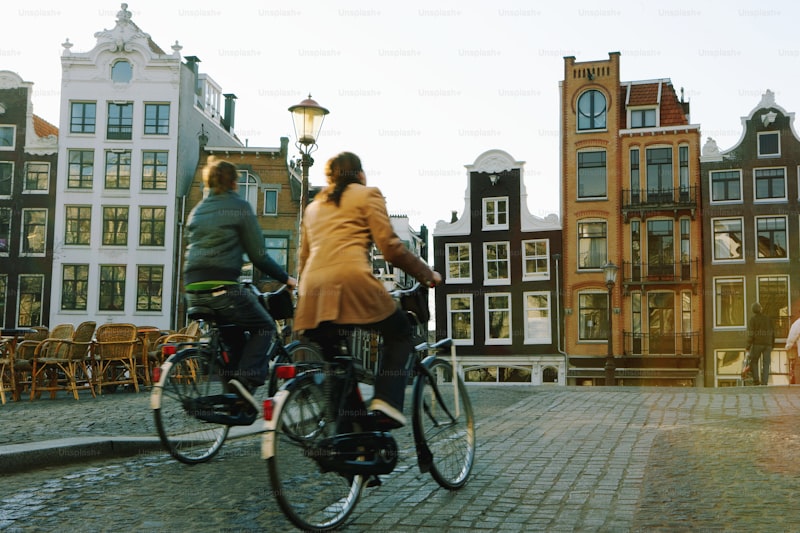
When it comes to exploring cities on two wheels, some urban centers stand out as havens for cyclists. These bike-friendly cities not only prioritize cycling infrastructure but also embrace a culture that encourages eco-friendly commuting. Imagine effortlessly pedaling through streets adorned with historic landmarks or vibrant neighborhoods bustling with life. In these cities, biking isn’t just a mode of transport; it’s a way of life.
Copenhagen, often hailed as the pinnacle of bike-friendly urban planning, sets a gold standard. With over 400 kilometers of bike lanes and routes, cyclists here outnumber drivers during rush hours. The city’s flat terrain and commitment to safety make it ideal for both seasoned cyclists and beginners alike.
Amsterdam, another leader in cycling culture, boasts an impressive network of bike paths that crisscross the city. From picturesque canals to iconic museums, every corner of Amsterdam is accessible by bike. The city’s infrastructure includes dedicated traffic signals for cyclists and ample bike parking facilities, reflecting its dedication to sustainable transport.
Portland, Oregon, stands out in the United States for its commitment to cycling. Known for its extensive network of bike lanes, cycle-friendly streets, and bike-friendly public transport options, Portland encourages residents and visitors to ditch cars in favor of bicycles. The city’s advocacy groups and community events further promote cycling as a viable alternative to driving.
Berlin combines rich history with modern urban planning to create a cyclist’s paradise. Its wide avenues, green spaces, and flat terrain make cycling an enjoyable experience. The city supports cyclists with bike-sharing programs and initiatives to improve safety on the roads, ensuring that biking remains a popular choice for getting around.
In these bike-friendly cities, the freedom of exploring at your own pace blends seamlessly with sustainable living. Whether you’re commuting to work, exploring tourist attractions, or simply enjoying a leisurely ride, these cities offer a refreshing perspective on urban travel. Discover the joy of biking in these vibrant urban landscapes where every pedal stroke brings you closer to experiencing the city like a local.
Pedal Paradise: Exploring the World’s Top 10 Most Bike-Friendly Cities

Imagine a city where cycling isn’t just a mode of transportation, but a way of life. These cities have embraced biking with open arms, creating environments where cyclists thrive and pedal power rules the streets. Let’s take a ride through the top 10 most bike-friendly cities around the globe, each offering its own unique blend of cycling culture, infrastructure, and scenic routes.
Copenhagen, Denmark, often hailed as the cycling capital of the world, leads the pack with its extensive network of bike lanes and cycling superhighways. Here, bicycles outnumber cars in the city center, making it a true haven for pedal pushers.
Amsterdam, Netherlands, needs no introduction as a cyclist’s dream destination. With its flat terrain, bike-friendly policies, and iconic canal-side bike paths, navigating this city on two wheels is both efficient and picturesque.
Portland, Oregon, USA, has earned its reputation as a cycling mecca with a community that’s deeply passionate about biking. Dedicated bike lanes, bike boulevards, and a culture that celebrates pedal power make Portland a standout in the US.
Berlin, Germany, combines rich history with a modern cycling infrastructure. Cyclists enjoy wide, well-maintained bike lanes and bike-friendly traffic signals, making it safe and convenient to explore this vibrant city on a bike.

Tokyo, Japan, surprises many with its dedication to cycling amidst a bustling metropolis. The city’s efforts in expanding bike lanes and parking facilities have made commuting by bike increasingly popular among Tokyoites.
Barcelona, Spain, offers cyclists both urban charm and seaside views. Its expanding network of bike lanes connects neighborhoods and tourist attractions, encouraging locals and visitors alike to explore the city on two wheels.
Montreal, Canada, stands out with its extensive bike path network that spans over 800 kilometers. Cyclists enjoy scenic routes along the St. Lawrence River and through city parks, making Montreal a paradise for urban bikers.
Utrecht, Netherlands, sets itself apart with the world’s largest bicycle parking facility and innovative bike infrastructure like the iconic Dafne Schippers Bridge. Cycling is deeply ingrained in Utrecht’s culture and daily life.
Seville, Spain, transformed itself into a bike-friendly city almost overnight with the implementation of an extensive bike lane network and public bike-sharing system. Today, cycling is a preferred way to get around Seville’s historic streets.
Strasbourg, France, blends French charm with a commitment to sustainable transportation. The city’s flat terrain and comprehensive bike infrastructure make it easy for locals and tourists to explore its medieval streets on two wheels.
Cycle Safely: Discovering the Best Bike Paths in the World’s Metropolises

Imagine navigating the bustling streets of global metropolises on two wheels, wind in your hair, and the thrill of exploration at every turn. Cycling has become not just a mode of transport but a lifestyle choice for urban adventurers seeking to blend fitness with sightseeing. Across the world’s busiest cities, dedicated bike paths offer a safe haven amidst the urban chaos, inviting cyclists to explore their surroundings with peace of mind.
In Amsterdam, often hailed as the cycling capital of the world, bike paths weave through historic streets and alongside serene canals, providing cyclists with a scenic route to discover the city’s charm. Pedaling through Copenhagen’s network of cycle-friendly lanes, riders pass by modern architecture and quaint cafes, reflecting the city’s commitment to sustainability and cycling culture.
For those craving a taste of history, Berlin’s bike paths lead riders past remnants of the Berlin Wall and through vibrant neighborhoods where East meets West in a harmonious blend of cultures. Meanwhile, in Tokyo, cyclists navigate a fusion of tradition and modernity, pedaling beneath cherry blossom trees in spring or alongside serene temples and bustling markets year-round.
In New York City, Central Park offers a serene escape from the concrete jungle, with winding bike paths that meander through lush greenery and iconic landmarks. Across the Pacific, Melbourne’s bike-friendly streets and coastal routes allow cyclists to explore the city’s vibrant arts scene and stunning beaches at their own pace.
Whether you’re a seasoned cyclist or a casual rider, exploring these global metropolises on two wheels offers a unique perspective and a sense of freedom unlike any other. So, gear up, grab your helmet, and embark on a cycling adventure through the heart of these dynamic cities. Discovering the best bike paths isn’t just about the destination—it’s about the journey itself, where every pedal stroke brings you closer to uncovering the hidden gems and local flavors that make each city truly unforgettable.
Green Lanes and Urban Rides: Unveiling the Top Cities for Cyclists
Known as the cycling capital of the world, Amsterdam boasts an extensive network of cycle paths and lanes that weave through picturesque canals and historic streets. Cycling here isn’t just a means of transportation but a way of life, with dedicated infrastructure ensuring safety and convenience for riders of all ages.
Famed for its commitment to cycling infrastructure and urban planning, Copenhagen is a paradise for cyclists. With over 390 kilometers of designated cycle lanes and innovative features like bicycle bridges and traffic signals tailored for bikes, it’s no wonder that over 50% of its residents commute by bicycle daily.
In the Pacific Northwest, Portland stands out for its cyclist-friendly policies and community support. The city’s comprehensive bike plan includes bike lanes, bike boulevards, and bike-sharing programs, encouraging residents to pedal their way through its vibrant neighborhoods and scenic parks.
Surprising to some, Tokyo has rapidly embraced cycling as a sustainable transportation option. With efforts to expand bike lanes and promote bike-friendly urban design, the city offers a unique blend of traditional charm and modern efficiency for cyclists navigating its bustling streets.
Berlin’s flat terrain and expansive green spaces make it ideal for cycling enthusiasts. The city continues to invest in cycling infrastructure, enhancing safety with cycle lanes and bike-friendly traffic policies. Cyclists here enjoy exploring the city’s rich history and vibrant cultural scene at their own pace.
Combining Mediterranean charm with cyclist-friendly initiatives, Barcelona features a network of bike lanes that connect its iconic landmarks and lively neighborhoods. Cyclists can enjoy scenic rides along the coastline or explore the city’s architectural wonders on two wheels.
As a leader in North America’s cycling scene, Montreal offers a blend of French culture and cyclist-friendly amenities. The city’s extensive BIXI bike-sharing system and dedicated bike lanes provide easy access to its vibrant festivals, historic sites, and scenic waterfront.
Bike-Friendly Urban Planning: How Cities Are Redefining Transportation
Imagine navigating a city where bike lanes crisscross through bustling neighborhoods like veins, seamlessly connecting residential areas with business districts and recreational spots. It’s more than just painted lines on the road; it’s dedicated infrastructure designed to prioritize cyclists’ safety and convenience. These lanes aren’t an afterthought but a core component of city planning, integrated into broader transit networks to encourage multimodal commuting.
What makes bike-friendly urban planning so impactful is its ability to democratize transportation. Suddenly, commuting isn’t solely reliant on cars or crowded buses; it’s about personal mobility and the freedom to navigate urban spaces at your pace. For many, it’s a chance to reclaim time otherwise lost in traffic jams or waiting for public transport.
Moreover, cities are embracing bike-sharing programs and electric bike initiatives, making cycling accessible to a broader demographic. From students to professionals, more people are opting for two wheels over four, enjoying the health benefits of exercise while reducing their carbon footprint. It’s a win-win for individuals and the environment alike.
In essence, bike-friendly urban planning isn’t just a trend; it’s a movement towards more livable cities. It challenges traditional norms of urban development, encouraging planners to prioritize people over vehicles and community well-being over congestion. As cities continue to evolve, expect bike lanes to become not just a feature but a symbol of progress towards sustainable, inclusive urban environments.
On Two Wheels: Cities Leading the Global Bike-Friendly Revolution
Imagine weaving through the vibrant streets of Copenhagen or Amsterdam, where bicycles outnumber cars. These cities have pioneered the concept of bike-centric infrastructure, where dedicated lanes weave seamlessly through the urban fabric. Here, cycling isn’t just a mode of transport; it’s a way of life. It promotes sustainability, reduces traffic congestion, and fosters a healthier, more active populace.

But it’s not just European cities leading the charge. Closer to home, cities like Portland and Minneapolis in the United States have embraced the bike-friendly ethos with gusto. Their extensive network of bike lanes, coupled with bike-sharing programs and cyclist-friendly policies, has transformed these urban centers into havens for pedal-powered commuters.
What makes a city truly bike-friendly? It’s the seamless integration of cycling into the urban planning framework. From protected bike lanes that prioritize safety to bike racks strategically placed near public transport hubs, every detail counts. It’s about making cycling accessible and appealing to all, from seasoned cyclists to those just starting their two-wheeled journey.
Moreover, the benefits extend beyond mere convenience. Cycling promotes a sense of community and connectivity. It allows residents to rediscover their city at a human pace, forging stronger bonds with their surroundings and with each other.
From Amsterdam to Copenhagen: Europe’s Iconic Bike Capitals
Imagine strolling along the cobblestone streets of Amsterdam or Copenhagen, surrounded by a sea of bicycles gracefully gliding past. These cities aren’t just renowned for their picturesque canals and historic architecture; they’ve also earned the prestigious title of Europe’s iconic bike capitals.
In Amsterdam, biking isn’t just a mode of transportation; it’s a way of life. With its flat terrain and extensive network of bike lanes, cycling here is both practical and enjoyable. Locals and tourists alike pedal through the city, exploring its charming neighborhoods and world-class museums. Whether you’re visiting the vibrant flower markets or the Anne Frank House, hopping on a bike lets you experience Amsterdam like a true local.
Meanwhile, Copenhagen boasts a cycling culture that’s deeply ingrained in its urban fabric. Known for its commitment to sustainability and green living, the Danish capital encourages biking as a primary means of getting around. Picture yourself cycling alongside the waterfront, past the colorful Nyhavn district, or through the serene parks that dot the cityscape. Copenhagen’s bike-friendly infrastructure makes it easy to navigate, with dedicated lanes and bike-sharing programs available throughout the city.
What sets these bike capitals apart isn’t just their infrastructure but also their attitude towards cycling. In both Amsterdam and Copenhagen, bikes are more than just a way to travel—they symbolize a commitment to health, sustainability, and community. Whether you’re commuting to work, running errands, or simply exploring the sights, hopping on a bike offers a unique perspective and a sense of freedom that can’t be matched by any other mode of transport.
So, next time you find yourself in Europe, consider exploring Amsterdam and Copenhagen on two wheels. Embrace the leisurely pace of biking as you soak in the culture, history, and charm of these iconic bike capitals. After all, the journey is just as important as the destination when you’re pedaling through cities that celebrate the joy of cycling.
Beyond Bike Lanes: What Makes a City Truly Bike-Friendly?
Imagine a city where cyclists are not just accommodated but celebrated. It starts with well-designed bike lanes that weave seamlessly through city streets, offering safe passage and connecting key destinations. These lanes are more than painted lines; they are protected, separated from vehicular traffic, ensuring cyclists feel secure and respected on the road.
But infrastructure alone isn’t enough. A bike-friendly city nurtures a community of cyclists, encouraging more people to pedal instead of drive. It fosters a culture where biking is seen as a practical and enjoyable mode of transport, supported by amenities like bike racks, repair stations, and bike-sharing programs.
Safety is paramount in a bike-friendly city. It means prioritizing measures like traffic calming, reduced speed limits, and clear signage that enhances visibility for cyclists and motorists alike. Education plays a crucial role too, ensuring both cyclists and drivers understand and respect each other’s rights on the road.
Beyond these practical considerations, the soul of a bike-friendly city lies in its accessibility and inclusivity. It means designing streetscapes that are inviting to all ages and abilities, making biking an option for everyone, not just the daring few. It’s about creating a city where hopping on a bike feels as natural as walking to the corner store.
Frequently Asked Questions
How can cities improve their bike-friendliness rankings?
Discover effective strategies for cities to enhance their bike-friendliness rankings through improved infrastructure, dedicated bike lanes, bike-sharing programs, education on road sharing, and promoting cycling as a sustainable transportation choice.
What are the health and environmental benefits of bike-friendly cities?
Discover how bike-friendly cities promote better health and a cleaner environment. Learn about reduced air pollution, improved physical fitness, and enhanced urban livability.
What criteria define a city as bike-friendly?
Learn about the criteria that define a city as bike-friendly, including infrastructure such as dedicated bike lanes, bike parking facilities, bike-sharing programs, and initiatives promoting cycling safety and awareness among residents.
How do bike-friendly cities support cycling infrastructure?
Learn how bike-friendly cities enhance cycling infrastructure to promote sustainable transportation options and improve urban mobility.
Which cities are considered the most bike-friendly globally?
Discover which cities around the world are recognized for their bike-friendly infrastructure and policies. Learn about urban centers renowned for promoting cycling as a sustainable and efficient mode of transportation.


